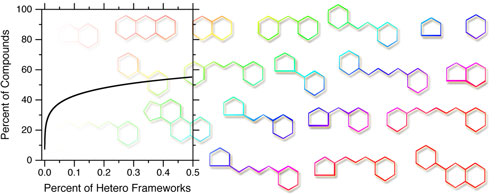| Posted: June 18, 2008 |
New research reports that 12 million molecules share 143 basic shapes |
|
(Nanowerk News) Chemists in Ohio have discovered that half of all of the known chemical compounds in the world have an amazing similarity in sharing only 143 basic molecular shapes. That sharply limits the number of molecular building blocks that chemists often deploy in efforts to develop new drugs and other products, the researchers say in a study scheduled for the June 20 issue of the bi-weekly ACS' Journal of Organic Chemistry ("Structural Diversity of Organic Chemistry. A Scaffold Analysis of the CAS Registry").
|
 |
| A vast number of chemical compounds share 143 basic shapes, scientists report. (Image: Eric Shively)
|
|
Alan H. Lipkus and colleagues note that researchers have known for years that certain features of molecules, such as rings of atoms and the bonds than link them together, appear time after time in hundreds of life-saving medications, food additives, and other widely used products.
|
|
Scientists often tend to focus on these well-known types of molecular scaffolding in their quest to select the most promising rings, linkers, and other components for building new drugs while overlooking less familiar structures, the researchers say.
|
|
In the new study, they analyzed the chemical frameworks of more than 24 million organic substances found in the ACS' Chemical Abstracts Service (CAS) Registry, the world's most comprehensive database of disclosed molecules. They found that half of the substances could be described by only 143 basic framework shapes. By paying more attention to a multitude of other molecular shapes, chemists might discover an array of useful rings, linkers, and other building blocks for tomorrow's drugs and other medical, commercial, and industrial products, the study concluded
|

